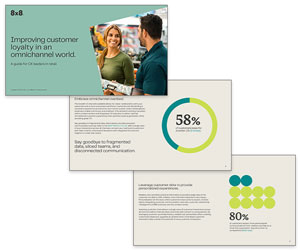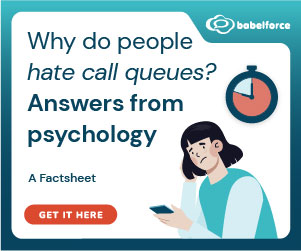8×8 have outlined some key questions any growing business should ask when starting to use AI to improve efficiency, productivity, and more.
Across most industries, it’s clear that we’re reaching peak AI hype. There’s a lot of noise surrounding the topic with many amazing use cases and some not-so-amazing ones, too.
How Will AI Help Me?
If an organization does its due diligence and focuses well during the adoption phase, the benefits can be significant.
Accenture research published in 2022 shows that companies successfully using AI to drive growth can attribute 30% of their total revenue to their AI solutions. Adopting AI has far-reaching benefits, including:
- Reducing costs
- Improving your employee productivity
- Increasing your company’s efficiency
- Transforming your customer experience
- Automating repetitive tasks
- Reducing human error
- Empowering decision makers.
Adding up the improvements for all businesses and across the global economy, it’s estimated that AI could add the equivalent of $2.6 to $4.4 trillion in value annually.
What Is the Right Type of AI for My Business?
There are a lot of different types of AI. How you use them depends on who you are and what your needs are.
If you’re a researcher at MIT, for example, then certain taxonomies will be useful for your role. However, the best way for businesses to think about AI technology is in terms of what it can do for your company:
- Data analysis. Using machine learning, AI can analyze vast data sets to find patterns, uncover anomalies, and make predictions about future trends such as customers’ buying behaviors.
- Customer service. Chatbots and virtual agents can provide 24/7 customer service, deliver faster response times, increase query resolution rates, and free up agents’ time.
- Task automation. Customer service is one example of automation, but there are many other cases in which AI will perform tasks automatically, such as transcribing calls, making meeting notes, completing invoices, and processing data for business intelligence (BI) applications.
- Content creation. Generative AI such as ChatGPT uses natural language processing (NLP) to understand and write text, create images, produce videos, and deliver other forms of content including email subject lines and ideas for messaging to customers.
AI options are becoming menu-like, and that’s great because it makes your choice easier when you’ve determined what you want to use it for.
You don’t need to focus on the ‘ingredients’ that make up the solution, just on whether it satisfies your business needs.
What Are the Risks Involved in Using AI?
All technologies come with risks. Crucially, many risks are made worse when businesses don’t try to mitigate them.
According to McKinsey’s latest state of AI research released in May 2024, inaccuracy in generative AI is the biggest risk, followed by intellectual property infringement, cybersecurity, data privacy, and other regulations.
However, the same report states that only 38% of companies are working to mitigate the risk of inaccuracy, and fewer are acting on the other leading risks.
AI of all types comes with risks. What’s key is that you are aware of this and try to mitigate them with appropriate processes and solutions.
How Much Time and Work Will It Take to Use AI in My Business?
AI adoption can be time-consuming if you take a time-consuming approach. In other words, you’ve got three options:
- Built-in or off-the-shelf
- Tailored
- Custom built from the ground up
Building an AI solution from the ground up is time-consuming and requires dedicated and sometimes costly resources.
Already tested, built-in or off-the-shelf solutions typically get growing businesses going fast.
Tailoring a solution with a provider is a middle ground that eliminates risk while also being quick to implement.
The same McKinsey research referenced above found that the most common timeframe for the adoption of generative AI is between one to four months for mostly tailored solutions.
However, solutions built from the ground up are 1.5 times more likely to take up to eight months to adopt.
Will AI Integrate With My Current Tech Stack and Is It Scalable?
AI is supposed to make work and life easier, improve your business processes, and improve overall efficiency.
However, if it doesn’t integrate into your business’s tech stack, then its functionality and effectiveness will be limited.
Using a proven technology partner and a tailored AI solution will ensure that it integrates with key business applications such as your customer relationship management (CRM) software, your accounting software, and your unified communications (UCaaS) and contact centre (CCaaS) software.
In use cases with these types of integrations, many AI innovations stand out. For example, contact centre support agents who use generative AI have seen a 14% increase in their productivity, according to a 2023 study from the National Bureau of Economic Research.
At the same time, companies that use AI to support contact centre agents have experienced a 20% decrease in their average handle time, notes Metrigy (2024).
Can You Show Me an Effective AI Solution in Action?
You want to find the sweet spot between using tech before it’s mature and being late to the party. Ideally, you want to be an early adopter or in the early majority.
This will give you a competitive advantage before the tech is widespread enough to become standard, and will help minimize any risks associated with being first out of the gate.
Asking to see AI solutions in action will help ensure that you get something that’s proven for businesses like yours. Detailed AI case studies are the best way to ensure that companies like yours have success with AI.
This blog post has been re-published by kind permission of 8x8 – View the Original Article
For more information about 8x8 - visit the 8x8 Website
Call Centre Helper is not responsible for the content of these guest blog posts. The opinions expressed in this article are those of the author, and do not necessarily reflect those of Call Centre Helper.
Author: 8x8
Published On: 22nd Jul 2024 - Last modified: 22nd Oct 2024
Read more about - Guest Blogs, 8x8






 8x8 is transforming the future of business communications as a leading Software-as-a-Service provider of voice, video, chat, contact centre, and enterprise-class API solutions, powered by one global cloud communications platform.
8x8 is transforming the future of business communications as a leading Software-as-a-Service provider of voice, video, chat, contact centre, and enterprise-class API solutions, powered by one global cloud communications platform. 































